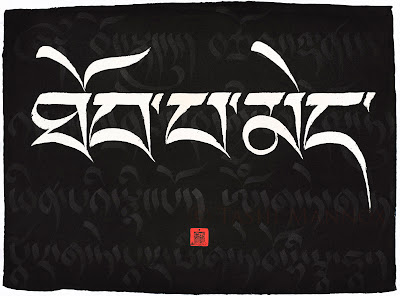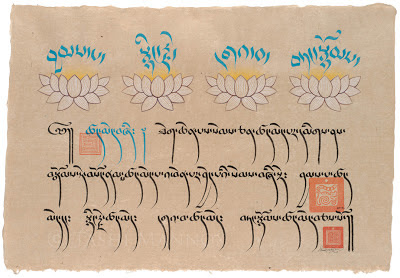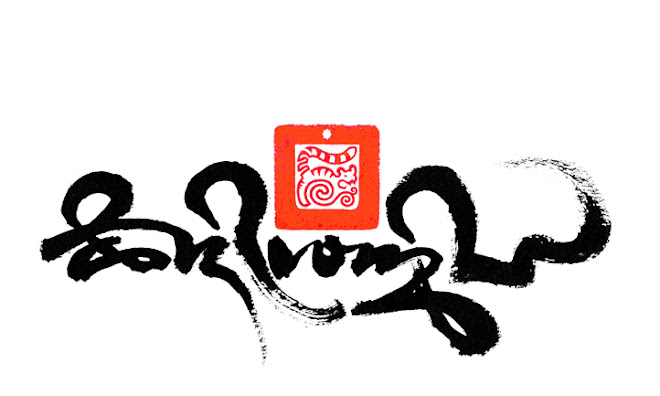RELATED TIBETAN SCRIPTS
Wednesday, 19 December 2012
Wednesday, 12 December 2012
Reflective qualities.
 |
| A new rendition of "The Heart of Emptiness" Tashi Mannox November 2012. |
The Heart Sutra and its mantra, nick named the Gaté mantra, is a continued inspiration for a number of Tashi's art pieces over the years. Recently Tashi was commissioned to create two new calligraphy pieces based on earlier artworks he had created. This following post tells something of the techniques used to create these masterpieces and the challenge in capturing their subtle qualities photographically in order to replicate as giclée prints.
In reference to the above image "The Heart of Emptiness". The central 'empty space of natural paper' is created by the Gaté mantra: "om gaté gaté para gaté para sam gaté bodhi swaha" encircling anti-clockwise, though to read the mantra from a stationary point (starting at the bottom) the mantra/paper would turn clockwise. The tails of the letters extend out into the darkness of space, whereas the vowel signs that sit above the letters are unavoidably left within the empty white space.
Across the whole of the black background is painted in another layer of black ink an extract from the Heart Sutra.
To arrange a length of calligraphy in a complete circle has a number of stages and difficulties. First is to choose the size of the letters which is determined by the width of the brush (the proportionate relation between the size of the brush or pen nib is explained in an earlier post here)
To begin with there is a fair amount of estimated guess work to fathom the right size length of text to fit in complete circle harmoniously within the limited size of the paper.
In the case of creating a circular Gaté mantra, three attempts were made that are shown as a collection of studies below.
These four studies on about A2 size water-colour paper can be viewed as individual art pieces here.
Only once the right size lettering is found to complete the right size circle of text; can this be applied with held breath to the actual artwork, such as "The Heart of Emptiness".
Another art piece inspired by the Heart Sutra shown below is called "None Attainment"that highlights one of the aspects taught through the Heart Sutra that expresses 'no concept' of anything that has 'gone beyond'.
The artwork depicts the words 'no attainment' in white lettering that appears to shine out over the black background where hidden is the title of the Heart Sutra as well as its mantra.
 |
| A new rendition of "None Attainment" Tashi Mannox November 2012 |
Both pieces; "The Heart of Emptiness" and "None Attainment" belong to Tashi's 'Black on Black' series that explores the coined technique of painting black calligraphy on black background, the effect of which gives a mysterious half hidden calligraphy that can be picked out because of the reflective quality of the ink.
Such reflective qualities are problematic to photograph because only one of the reflective moods can be captured at any one time dependent on how the image is lit.
The below examples shows two very different ways in which the black on black calligraphy and background is exposed. In other light condition the background lettering can seen to disappear altogether.
On the left side image the photograph has picked up the lettering as black with the background more reflective and a lighter tone.
On the right side the lettering is reflecting lighter the black background completely inverted to the image on the left.
When reproduced as prints, that is totally reliant on the quality of the photograph, the subtle reflective quality that reveals its self when viewing the original art work, is somewhat limited in the print productions, never-the-less they still stand as strong printed artworks in their own right.
Saturday, 24 November 2012
E.K. interviews Tashi Mannox
EMPTY KINGDOM MEDIA
interviews Tashi Mannox
❝This summer, a friend visiting my home and studio brought with her a young Tibetan man who is currently studying architechture in London. He was obviously moved by my Tibetan calligraphy art pieces that are about my home. I was astonished to learn from him that my work is much appreciated by the younger Tibetan communities in India and the West, who enjoy to up-load artworks onto their iPhones as screen savers etc. When I asked why my work is so popular, he answered that for young Tibetans it gives them hope and appreciate the fact that their rich cultural heritage, such as calligraphy, has been brought into the modern world tastefully and not forgotten to the dust of time.❞
Monday, 22 October 2012
4th International Exhibition of Calligraphy - Moscow
Once again the Russian Federation hosts the worlds foremost exhibition of contemporary calligraphy in Moscow. This 2012 biannual event runs between 1st November until the 15th December. A diverse and colourful exhibition that represents over 40 world class calligraphy artists of different language traditions, who have contributed calligraphic masterpieces to celebrate the beauty of handwriting, excelling their artistic abilities in the name of keeping such calligraphy traditions alive.
The exhibition officially opened on the 1st November with a grand event that attracted much media attention as captured here.
The exhibition officially opened on the 1st November with a grand event that attracted much media attention as captured here.
A beautifully styled catalog of the exhibition artworks and their creators has been skillfully made available 'electronically' :
There is also a 'virtual excursion' that allows remote live viewing of the exhibition via CCTV cameras placed strategically around the gallery halls.
Since the Contemporary Calligraphy Museum of Moscow first held their international calligraphy exhibition in 2008, Tashi Mannox has been invited to exhibit with three of their biennials. This year Tashi especially created two art pieces and donated a third for the 2012 show.
One such piece especially created, as shown in the above snap-shot of the catalog, called "Homage to the Three Jewels" can also be seen with a more detailed explanation in a previous blog post here.
The other calligraphy art piece exclusively created for Moscow is called "The Four Immeasurable States" (as below) another calligraphy based on a classical Buddhist theme and popular for a strongly growing Buddhist community in Russia.
༄། ཚད་མེད་བཞི། །
 |
|
"The Four Immeasurable States"
Chinese ink and Japanese mineral paint on
Bhutanese tsasho paper,
57x84cm ⓒ Tashi
Mannox 2012.
|
Seated on the four open lotus flowers are the four immeasurable states:
བྱམས་པ་ སྙིང་རྗེ་ དགའ་བ་ བཏང་སྙོམས་
Love, Compassion, Joy,
Equanimity.
These four key words are highlighted in blue calligraphy of the Drutsa script
style. Below which is a round
tailed Drutsa script from the 14th century Tibet. This particular rare round tailed Drutsa was gathered together after months of research pouring over ancient Tibetan manuscripts, in Uchen this reads as:
༄།ཐེག་ཆེན་པས་སེམས་ཅན་ཚད་མེད་པར་དམིགས་ནས་བསྒོམས་ཏེ་བསོད་ནམས་ཚད་མེད་པ་འཕེན་པར་བྱེད་པའི་སེམས་བཞི་སྟེ།བསོད་ནམས་ཚད་མེད་པ་འཕེན་པར་བྱེད་པའི་སེམས་བཞི་སྟེ། བྱམས་པ་ཚད་མེད་དང། སྙིང་རྗེ་ཚད་མེད། དགའ་བ་ཚད་མེད།
བཏང་སྙོམས་ཚད་མེད་བཅས་སོ།
“According to the Mahayana by meditation that focuses on measureless
beings there are four states of mind that set in motion measureless punya
(auspicious or positive effects or states), namely:
Measureless love, measureless compassion, measureless joy and measureless
equanimity”
Translation by Lama Shepen Hookham at the
request of Tashi Mannox June 2011.
The below photos taken at the 4th International Exhibition of calligraphy showing four of Tashi's artworks displayed among other calligraphy traditions, such as Islamic and classical Chinese.
 |
| "The Four Immeasurable States" |
 |
| The exhibits |
 |
| contemplation |
 |
| "Seven line prayer to Guru Rinpoche" |
 |
| "Seven line prayer to Guru Rinpoche" detail |
 |
| "Homage to the Three Jewels" |
 |
| "Sacred Mantra" and "Homage to the Three Jewels" |
 |
| "Sacred Mantra" close up observation |
 |
| "Sacred Mantra" detail |
 |
| "Sacred Mantra" |
Up close.... Visitors during the official opening of the IV International Exhibition of Calligraphy 2012, take in detail of one of Tashi's earlier art pieces called "Sacred Mantra" donated to the Moscow Contemporary Calligraphy Museum in 2010.
Tuesday, 9 October 2012
Tallinn Calligraphy exhibition
From 9th to near the end of October, the Society of Himalayan Culture in Tallinn presented the "Himalayan Film and Cultural Days 2012". This featured a joint exhibition in the Kullo Gallery at the heart of the beautiful medieval capital of Estonia. Tashi Mannox exhibited a number of his major calligraphy artworks along with other Himalayan and Tibetan artists Puntsok Tsering, and Tashi Norbu.
 |
| The Kullo Gallery, Tallinn, Estonia. |
The Society of Himalayan Culture also especially commissioned calligraphy works from artists of the smaller least known Himalayan ethnic groups, these included the rare Limbu*, Magar** and the more known Ranjana*** scripts. *scroll down below.
A Sanskrit prayer for well being and protection, arranged by the artist as a traditional illuminated title page of Indian and Tibetan Buddhist Manuscripts. The Script style is called Ranjana of the indigenous Newar*** people of the Kathmandu Valley.
The Mani mantra in the Ranjana script that has a close relationship with its grandfather Lansta Sanskrit.
Tashi lead a two day Tibetan writing workshop in the Kullo exhibition space, that was very well attended, a list of activities are shown in the link here.
Tashi explaining the construction of the 'hum' syllable and its deeper symbolic meaning.
Attentive students.
A helping hand.
Happy participants from the first days work.
Participants on the second day.
The conclusion of the workshops ended with Tashi demonstrating how to execute a 'free' expressive style calligraphy.
*LIMBU SRIJONGA
Limbu is a Tibeto-Burman language spoken in the Himalayan
regions of Nepal, Bhutan, Sikkim, Kashmir, and Darjeeling in India.
According to traditional histories, the script was first invented in the late
9th century by King Sirijonga Haang. This fell out of use, to be reintroduced
in the 18th century developing during the expansion of Buddhism when Limbuwan
(small independent states of Limbu) was administered by Sikkim. The Limbu hero
Sirijonga (Te-ongsi Sirijunga Xin Thebe), a great
educationalist, scholar, historian and philosopher of that time, began an
active campaign against this Tibetan Buddhist cultural encroachment by
promoting Limbu script, language
and culture from village to village. For this he was killed by the Sikkim
Buddhist authorities, tied and shot by arrows. Limbu learning centers were
destroyed and Sirjonga’s disciples murdered or suppressed. For his work,
Sirjonga was considered a martyr for Limbus and the Limbu script has been
subsequently named after him as Sirjonga script.
Today
Limbu is recognized in Sikkim as one of its official languages since 1970 and school course books in
Limbu are available. In Nepal, the
story of prosecuting Limbu language promotion continued, particularly with
teachers like Bir Nembang arrested in the 1980s for secretly teaching Limbu.
Many of these teachers fled to India. Only after a democratic revolution in
1990 Limbu language activists were able to freely operate and openly work for
the development of Sirjonga script.
**MAGAR AKKHA RIKA
Magar languages are spoken in the
Himayalas from Nepal to Sikkim in India. During the 17th and early
18th centuries, the Magar kingdom was one of the strongest of west
Nepal. Later they served as a large bulk of the footsoldiers for Hindu Khas
Shah kings who went on to unify Nepal . Since the 19th century they
occupied the largest number of Gurkha soldiers under the British Army and
adopted many Hindu practices as well as Devanagri script since they did not
have script at that time. They speak 3 vastly different languages called Kham,
Kaike and Dhut and together represent the largest indigenous group of Nepal
today.
After the democratic revolution of
Nepal in 1990, Magar indigenous rights activism grew and started shifting
customs away from what they saw was former oppressive Hindu rule. In 1992, a key Magar scholar, MS Thapa
lay claim that Buddha, having been born in West Nepal, must have also been
Magar as the ancient kingdoms of that time in that area must have been Magar.
Since the script used largely at that time since 4th century BC
Ancient India was Brahmi, Magars
must have used Brahmi script which has been named as Akkha Rika according to Buddhist texts. Furthermore “Rikaa” means
script or alphabet in classical Magar language.
From these ideas of MS Thapa, Magar
activists began developing Akkha Rika,
essentially a modernized form of Brahmi, adding more symbols to fit sounds in
the Magar language. This script became adopted as the official script of Magars
and is used in publications to teach Dhut Magar language. This is a new process
as most young people are only beginning to get introduced both to the language
and the script. This 20 year old script is still in development to suit the
other Magar languages, and has inspired some ethnic groups such as the Gurung
who are now using the Brahmi model to develop a new script today.
***NEWAR SCRIPTS
The Newar are the indigenous people of the
Kathmandu Valley as well as its traditional artists, builders and artisans.
Their Tibeto-Burman language, more correctly known as Nepal Bhasa, has been
written in a number of scripts, primarily Ranjana and Prachalit script derived
from Brahmi script.
Ranjana developed in Kathmandu Valley during the 10th
century AD and spread into other areas of Asia from Mongolia to Japan for
sacred Tibetan Buddhism texts, and was also used to write Maithili language for some period. The valley
developed 9 types of scripts including Prachalit, Ranjana,
Golmol, and Bhujinmol but only Ranjana
and Prachalit continue in use today.
Nepal Bhasa began suffer after the Shah Dynasty from West Nepal took over Kathmandu Valley
in the late 18th century. The repressive policies of the Rana Dynasty (1846–1951
AD) attempted to wipe it out. In 1906, legal documents written in
Nepal Bhasa were declared unenforceable, rulers forbade literature in Nepal
Bhasa, and writers were sent to jail. In 1944, Buddhist monks who
wrote in the language were expelled from the country. After the overthrow of
the Rana Dynasty in 1951,restrictions on publication in Nepal Bhasa were
removed. Books, magazines and newspapers appeared.
Today it is experiencing a revival due to recent cultural awareness.
- courtesy of Premila van Ommen
Monday, 6 August 2012
Great lengths.....
 |
| The great Mahasiddha Śāntideva. |
In June this year 2012, Tashi was contacted by a Tibetan man called Yeshi who lives in the Eastern Tibetan/Chinese Provence of Yunnan. So eager was Yeshi to commission Tashi to create a calligraphy, he made a long distance phone-call from the capital Kunming to discuss the phrases Yeshi wanted in the Khyug (quick style) Tibetan calligraphy.
The chosen phrases was a four line stanza to generate a mind of Enlightenment (as below), originally composed by the great Indian scholar Shantideva, who was the author of some of the greatest Buddhist works, such as the Bodhicharyavatara.
 |
| "For as long as space exists and living beings endure. May i too remain to dispel the misery of the world" |
The phone-call and request was somewhat of a surprise to Tashi, who asked Yeshi why he needed to ask an Englishman half way around the world to create a Tibetan calligraphy to send back to Tibet and surely their must be somebody more local to him, such as a Lama who could elegantly scribe the stanza. Yeshi replied that it was very difficult to find a person who is able because the Tibetan written language was little practiced and much forgotten.
Above is Yeshi, proudly wearing his new tattoo, that is important to him representing the Tibetan heritage he belongs, as well as the wisdom in it's meaning of Bodhicitta; poetically expressed in the calligraphy that is topped with a crescent moon and Bindu like sun, inspired by another of Tashi's iconic artworks called "Precious Human Existence".
The conservation of the Tibetan written language and its many script styles is at the heart of Tashi's work as a contemporary Tibetan calligraphy artist.
"Ancient traditions take many generations to develop and mature. However with neglect, such traditions can easily be lost in just one generation.
Documentation and reproduction is essential for their survival in keeping the ancient traditions alive"Sunday, 27 May 2012
Foul Mud, Pure Lotus.
This triptych depicts
a lotus flower in stages of bud to bloom to seedpod, representing the passing
of time ‘past, present and future’.
In Eastern iconography, the
lotus flower is symbolic of purity and is considered an analogy of transformation
as one tames ones own negative emotions that fuels a positive change. As the
more rich and foul the composting matter at the bottom of a pond, the more
it nourishes the most glorious of flowers, that stand proud and pristine above
the water surface, un-splashed by the (Samsaric) bustle of pond life.
Chinese ink, gesso and silver
leaf on mounted board, Tashi Mannox 2002.
Subscribe to:
Posts (Atom)

























